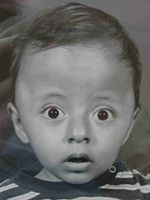Crouzon Syndrome
Danielle Mercer1, Fern Tsien2, and Barbara Gordon-Wendt1
1 Department of Communication Disorders, LSUHSC School of Allied Health Professions
2 Department of Genetics, LSUHSC School of Medicine
Crouzon syndrome affects 1 in 60,000 live births in the United States. Crouzon is a craniosynostosis syndrome, which means the bones in the skull fuse prematurely during fetal development. This causes changes in the structure of the skull, which leads to a characteristic facial appearance. The skull changes can also cause hearing loss, which is usually conductive. Some patients have narrow ear canals, which can also contribute to conductive hearing loss. Those with Crouzon syndrome usually have normal intelligence. Reconstructive surgery may be needed to improve appearance and to prevent the prematurely fused sutures from damaging the brain. Crouzon syndrome is inherited as an autosomal dominant trait, but about 25% of cases are due to new mutations.
Crouzon syndrome signs and symptoms:
- Shallow eye orbits with protruding eyes
- Strabismus (eyes drift, or do not line up with each other)
- Beaked nose
- Underdeveloped jaw
- Dental problems
- Conductive hearing loss
- Cleft lip and palate
- Large forehead
For more information on Crouzon syndrome, visit the following links:
http://ghr.nlm.nih.gov/condition/crouzon-syndrome
http://www.seattlechildrens.org/medical-conditions/bone-joint-muscle-conditions/crouzon/
For information on support groups for Crouzon syndrome, visit the following links:
http://www.faces-cranio.org/Disord/Crouzon.htm

Child with Crouzon syndrome
From http://www.thecraniofacialcenter.org/crouzon.aspx
